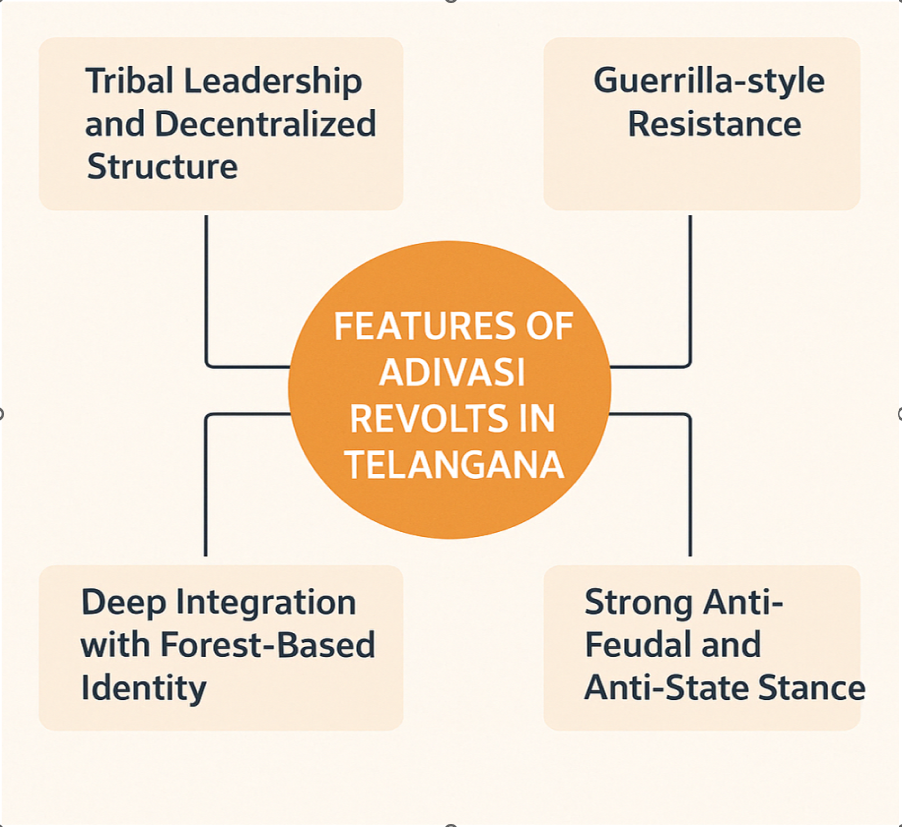There are no items in your cart
Add More
Add More
| Item Details | Price | ||
|---|---|---|---|
Thu Apr 24, 2025
Approach:
Introduction: Briefly contextualize the exploitation of Adivasis under the Nizam's rule and introduce the Ramji Gond revolt as the first major tribal uprising in Telangana.
Body:
Causes of Adivasi Revolts:
1. Feudal Exploitation and Bonded Labor (Vetti Chakiri):
• Doras enforced unpaid labor on tribal communities, sparking resistance (e.g., Ramji Gond in Adilabad, 1853–60).
2. Land Alienation and Forest Displacement:
• Industrial ventures like Sirpur Paper Mill displaced Gonds and Kolams.
3. Unjust Revenue and Taxation Policies:
• Imposed forest taxes (e.g., Bancherai Pannu, Dumpa Patti) sparked Komaram Bheem’s revolt.
4. Militarized State Suppression:
• Razakars and Nizam’s forces violently suppressed uprisings in Utnoor, Sirpur.
5. Cultural and Political Marginalization:
• Exclusion from education, governance, and control by non-local elites triggered resistance.
6. Land Encroachment and Social Exploitation:
• In Khammam, land grabbing, heavy taxation, and abuses fueled tribal dissent.
Significance of the Revolts:
1. Ramji Gond’s Revolt (1853–60):
• Early military resistance; his martyrdom at "Veyyi Urula Marri" is iconic.
2. Komaram Bheem’s Revolt (1920s–40):
• Advocated “Jal, Jungle, Zameen,” becoming a symbol of tribal rights.
3. Foundation for Telangana Armed Struggle (1946–51):
• Adivasi revolts contributed momentum to broader anti-feudal peasant revolts.
4. Catalyst for Land and Forest Reforms:
• Influenced post-independence policy debates on tribal land rights.
5. Grassroots Governance in Khammam:
• Emergence of people’s courts and Sanghams prefigured decentralized justice.
6. Enduring Legacy:
• Komaram Bheem’s legacy is institutionalized as a state festival, embedding tribal struggles in Telangana's identity.
Conclusion: These revolts embodied tribal demands for justice and autonomy, laying the moral foundation for the Telangana Armed Struggle and later reforms.,
Introduction:
For generations, tribal communities across India were exploited for unpaid labor, often without basic rights or dignity. In the Hyderabad State, this exploitation under Nizam’s oppressive rule led to periodic tribal revolts, beginning with the Ramji Gond revolt which was the Telangana’s first major Adivasi uprising.
Body:
Causes of Adivasi Revolts
1. Feudal Exploitation and Bonded Labor (Vetti Chakiri):
-Tribals were forced to work without pay under landlords (Doras). For example, in Adilabad, Ramji Gond mobilized Gonds and Rohillas to resist forced labor during 1853–60.
2.Land Alienation and Forest Displacement:
-The establishment of the Sirpur Paper Mill led to the takeover of forest lands for raw material, displacing Gonds and Kolams from traditional habitats.
3. Unjust Revenue and Taxation Policies:
-Under the 1917 Forest Act, tribals had to pay Bancherai Pannu to graze cattle and Dumpa Patti for firewood. Komaram Bheem led a revolt specifically against these taxes, which undermined tribal livelihoods.
4. Militarized State Suppression:
-The Nizam’s administration deployed Razakars and police to suppress tribal resistance, especially in regions like Utnoor and Sirpur.
5. Cultural and Political Marginalization:
-Tribals were excluded from education and governance. Bheem’s opposition to domination by non-local officials (Marathas, Muslims, Telugu landlords) reflects this discontent.
6. Resistance to Land Encroachment and Social Exploitation:
-In the Bhadrachalam–Yellandu region of Khammam, Koya and Lambada tribes faced land grabbing, heavy taxes, and social abuses by feudal agents. These injustices fueled resentment and led to strong tribal resistance against the Nizam’s rule.
Significance of the Revolts
1. Ramji Gond’s Revolt (1853–1860):
-Captured Manikgarh Fort and resisted British-Nizam control. His execution at "Veyyi Urula Marri" became a tribal martyrdom symbol.
2. Komaram Bheem’s Revolt (1920s–1940):
-Advocated the slogan “Jal, Jungle, Zameen”. Though martyred, he laid the ideological base for tribal rights.
3. Foundation for Telangana Armed Struggle (1946–51):
-Adivasi uprisings merged into the broader peasant movement that liberated around 3,000 villages from feudal control.
4. Catalyst for Land and Forest Reforms:
-These movements influenced early land redistribution debates post-independence, especially in Andhra Pradesh.
5. Grassroots Governance in Khammam:
-In the Khammam revolt, tribal communities enforced justice through Sanghams and people’s courts, showcasing early forms of self-rule and decentralized resistance.
6. Enduring Legacy in Telangana's Identity:
-Komaram Bheem's death anniversary is now observed as a State Festival, symbolizing the mainstreaming of tribal struggles in Telangana’s political culture.
Conclusion:
The Adivasi revolts were landmark expressions of resistance, highlighting tribal identity and the demand for justice. Though they did not overturn the regime, they exposed deep-rooted exploitation and laid the moral and political foundation for later movements like the Telangana Armed Struggle (1946–51), which advanced land rights, social justice, and democratic inclusion for the marginalized.
Additional Embellishment:
